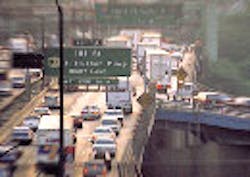According to an updated report by the Texas Transportation Research Institute (TTI), traffic congestion on U.S. highways has receded slightly over the past few years due to high fuel prices and the economic recession. But the group’s researchers don’t expect that trend to continue and thus are urging for continued investment in roadways.
“Travelers spent one hour less stuck in traffic in 2007 than they did the year before and wasted one gallon less gasoline than the year before – even before the current recession,” said TTI Researcher Tim Lomax. “The differences are small, but they represent a rare break in near-constant growth in traffic over 25 years.”
TTI Research David Schrank noted that the ongoing U.S. recession could prolong this effect, but warned that the slowdown in congestion growth will be temporary. When the economy rebounds, expect traffic problems to do the same, he said.
“This is a very small change,” Schrank pointed out. “No one should expect to be driving the speed limit on their way to work because of this. That's because the average traveler still needs 25% more time for those trips.”
The most current information on the nation's traffic picture is outlined in TTI’s 2009 Urban Mobility Report, which tracks a quarter century of traffic patterns in 439 U.S. urban areas from 1982 through 2007. Other highlights from the research illustrate the effects of the nation's traffic problems:
- The overall cost (based on wasted fuel and lost productivity) reached $87.2 billion in 2007 — more than $750 for every U.S. traveler.
- The total amount of wasted fuel topped 2.8 billion gallons — three weeks' worth of gas for every traveler.
- The amount of wasted time totaled 4.2 billion hours — nearly one full work week (or vacation week) for every traveler.
The American Trucking Associations (ATA) said that the economic costs of traffic congestion have increased 63% over the past decade. ATA noted that while public transportation could supplement highway capacity expansion on certain corridors in densely populated areas, highway improvements are the only viable, cost-effective solution to addressing congestion in the vast majority of communities.
“The TTI report found that 75% of travel time and congestion cost savings produced by public transportation systems were concentrated in just six cities, with New York City capturing half of the nationwide benefits,” ATA said.
“A robust investment in transportation infrastructure is the most effective way to alleviate our nation’s looming congestion problems,” the trucking lobby stated. “We must invest our limited resources wisely by focusing specifically on traffic ‘chokepoints’ that suffer the worst from congestion. Greater highway capacity will aide passenger mobility and help stimulate our economy through improved freight productivity. According to the TTI report, 12,676 new lane-miles of highways and roads are needed to keep up with congestion.”
TTI’s Schrank and Lomax recommend a balanced and diversified approach to reducing traffic congestion – one that focuses on more of everything. Their suggested strategies include:
- Get as much use as possible out of the existing transportation system .
- Add roadway and public transportation capacity in the places where it is needed most
- Change our patterns, employing ideas like ridesharing and flexible work times to avoid traditional "rush hours."
- Provide more choices, such as alternate routes, telecommuting and toll lanes for faster and more reliable trips.
- Diversify land development patterns, to make walking, biking and mass transit more practical.
- Adopt realistic expectations, recognizing for instance that large urban areas will be congested, but they don't have to stay that way all day long.
"The best solutions are going to be those in which actions by transportation agencies are complemented by businesses, manufacturers and commuters," noted TTI’s Lomax. "There's a mindset that says that this is a city government's job or a state DOT's job, but the problem is far too big for transportation agencies alone to address it adequately."
About the Author
Sean Kilcarr
Editor in Chief
Sean Kilcarr is a former longtime FleetOwner senior editor who wrote for the publication from 2000 to 2018. He served as editor-in-chief from 2017 to 2018.
